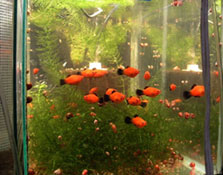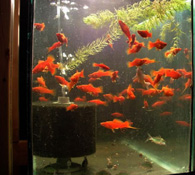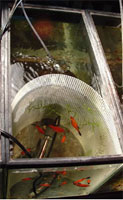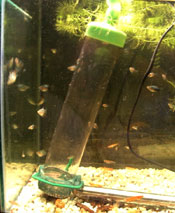by Frank Cowherd
Saving the livebearer fry from being eaten by their parents is only the start of getting the fry to adult size so they can be put back into the main display tank. The next part is raising them so they grow healthy and quickly. Food type and amount are critical to raising most of the saved babies to adult size even in the baby-saver set up as described in Part 1: Keeping Livebearer Babies From Being Eaten and illustrated in Figure 1.
But these food-related factors are not the only critical parameters. When you feed heavily, the water quality goes bad, the tank bottom gets ugly, fungus can start to grow on the plants or the sponge filter, and the filter gets plugged with debris. All of these potential problems need to be addressed by those who wish to keep, raise, and proudly display their beautiful, fascinating, and home-raised tropical fish.
Livebearer versus Egg Layer Fry
Raising livebearer fry is actually easier than raising most egg-layer fry. The advantage livebearers have over egg-laying fish is that the eggs are incubated in the female’s body. The developing livebearer embryos do not get nourishment from the female, thus they have no belly buttons. They get all of their nourishment from their own egg. When the female (or mother fish) drops them, they have used up most, if not all, of the nourishment in the egg and are ready to forage for food within an hour or so. In other words they are fully functionalfish at birth.
Egglayer fry usually hatch with a large egg sac and are not able to swim freely. They have no need to forage until the egg sac is adsorbed after which, usually at least five days, they become free swimming. From the time the eggs are laid until the fry are free swimming, the eggs/fry are prone to attack by fungus, bacteria, and other fish as well as diseases, particularly because they are not moving. In other words they are not fully functional for a long time.
FOOD
Size of Food
The deciding factor for what food to feed is the size of the fry’s mouth. If you offer foods that are larger than their mouth, you will starve the fry. They might live a few days on infusuria already growing in the tank, but that results in only a few fry surviving. As the fry grow, larger foods can be added, but they will usually still take the smaller foods.
Dried Foods are Convenient But Overfeeding Can Lead to Problems
Fortunately livebearers will take dried foods as a first food. Just provide it in a proper size. Simply crushing a really dry flake food between your fingers as you drop it onto the surface of the tank is all that is needed. If it is not easily crushed, the machines that are used to grind coffee beans are also great for grinding dried fish foods, even pellets, to a powder of a size you need.
A great initial dry fry food is CYCLOP-EEZE, because it is nutritious and already the right size for livebearer fry, and it is available from your LFS. It is fed by mixing a small pinch of the material in water. Then pour the mixture into the tank, directed to where the fry are.
Dried foods of the right size are useful but the fry will not eat all that is put into the tank. The excess will fall to the bottom, get in cracks and crevasses and quickly start to decay. The bacteria involved in decay multiply and consume oxygen and produce waste products, which combined with fish waste help to deteriorate the quality of the water.
Bad water quality can and, particularly if allowed for any length of time, will lead to either diseases or deformities in the fry. Velvet and dropsy are two common diseases caused by poor water quality. Missing gill covers and possibly lack of a swim bladder are examples of deformities cause by environmental problems. Such deformities are thought to be the result of poor water quality particularly in the first weeks of their lives.
Live Foods Have Advantages
Live foods are much better than dried foods because the fry will seek out live food even if it stays on the bottom of the tank. The motion of the live food attracts the fry, which are visually oriented animals. Fry will eat live food until they are stuffed and their bellies are extended.
I particularly like to feed live foods for the first week or two and then introduce dried foods later. If the fry are really small, I start out with infusoria. For example, least killifish are livebearers that are very small when born and do best with infusoria as a first food. After a few days microworms or baby brine shrimp can be added. Powdered dried food can be added later, particularly as you run out of enough live food to feed.
Even with live food you do not want to overfeed. Although live foods will stay alive in the tank for a considerable length of time, most live foods will die and pollute the tank if overfed. The length of time live food will remain alive depends mostly on the oxygen content of the tank, particularly at the bottom of the tank where the excess live food will accumulate. So poor water quality can impact the time the live food remains alive. Microworms will stay alive for around a day in the bottom of a tank provided there is a good flow of oxygenated water. In stagnant water the microworms will be dead in hours.
Brine shrimp are salt-water creatures so their life in a freshwater aquarium depends mainly on the salt content. Adding a small bit of salt (up to a teaspoon per gallon) to the water can prolong the time that the brine shrimp will remain alive. But brine shrimp cannot be expected to last more than 6 or 8 hours in fresh water. And when they die, they decay rapidly. The bacterial bloom that accompanies this decay can be fatal to the fry.
Gelled or Frozen Foods Need to Be Consumed Quickly
Gelled or frozen foods can also be fed with the same requirement of it all being consumed within five minutes. The minor problem that I have with this type of food is that some of it disperses into the water as a cloud. The small particles in the cloud are too small to be consumed by the fish and thus only serve to feed the bacteria and infusoria in the tank. In other words, water quality can go bad more quickly with gel and frozen type foods than with other foods. Knowing this just means more frequent water changes. Since gel and frozen foods are often a bit more nutritious than dried foods, more frequent water changes can be justified. But cost and convenience are other factors to consider which are not in favor of gel and frozen foods. These foods can also be considered as alternatives to live foods.
How Much Food
To find out how much food is the right amount to feed, start by feeding a small amount of any food of the right size and observe the fry. If they eat all that was added quickly, you can add more. A good guideline is to feed no more than the fry can eat in four or five minutes. To get good growth, you need to feed heavily with both dry and live foods. I find that one morning feeding and one late afternoon feeding of a good dry food mixture followed by a late evening feeding of live food will produce rapid growth. (See Figure 2 and Figure 3.) Watch the fish for at least 5 minutes after feeding dry foods. You should not see any excess food anywhere in the tank after the 5 minutes. If you do, you should feed less.
For the live food feeding, all should be consumed in 5 minutes unless you are feeding infusoria, daphnia or microworms. If you are feeding microworms, a small excess is fine as long as there is a good flow of oxygenated water. Infusoria and daphnia will live until eaten.


Additional Notes on Live Foods
Depending on the size of the livebearer fry’s mouth, which, of course, gets larger with age, the live foods that you can feed, listed in approximate order of size, are infusoria (amoeba, paramecium, euglena, etc.), microworms or vinegar eels, baby brine shrimp, daphnia, grindle worms, white worms and earthworms.
You can isolate and feed small daphnia, grindles and white worms for feeding. Cultures of daphnia, grindle and white worms can be easily separated into small and large sizes. Daphnia can be separated using nets of different mesh sizes. Collect all daphnia in a fine net. Then transfer these daphnia to a net with a larger mesh size already placed in water. The small daphnia that pass through this net can be fed to the fry.
The grindle and white worms have to be harvested in the normal manner and then mixed in a quart of water. When the water mixture is allowed to stand, the larger worms settle quickly leaving the smaller worms in the water column. The smaller worms can be poured into another container and then fed using a baster or dropper.
Although I find them more useful for conditioning adult fish, earthworms can be chopped to the size you want to feed to your larger fry.
One live food that can safely be added in excess is daphnia. The daphnia that is too large for the fry to eat will live and reproduce. The newly born daphnia are quite small and make a good food for the fry. Daphnia have the added benefit that they eat bacteria and infusoria, and thus, they help to keep the water cleaner than it otherwise would be. If you are feeding very small fry with infusoria, you should not add daphnia. Daphnia will eat the infusoria, possibly starving the fry.
WATER QUALITY
Thus far I have only mentioned water quality as it is affected by excess food. But even if you feed the exact amount of food for the number and size of fry, good water quality can only be maintained by good filtration and routine water changes.
If you are raising 20 to 40 livebearer fry in a 10-gallon tank and feeding them heavily to get good growth, you need to do whatever it takes to maintain good water quality. This may mean weekly, but it could mean daily water changes of anywhere from 10 to 90 percent. The way to tell is to monitor a number of things. First, note the clarity of the water. Second, observe the amount of debris on the bottom of the tank. Third, determine the color of the water. And fourth, observe the behavior of the fish. You also have to know the hardiness of the type of fish you are raising. Livebearer fry are considered hardy.
If the water is cloudy, the sponge filter is probably loaded with debris and needs to be cleaned. Do this in conjunction with a 10 to 30 percent water change.
If there is more than a thin layer of debris on the bottom, some water needs to be replaced. Do a 10 to thirty percent water change. Cover the end of the siphon with a net held on with rubber bands and siphon out as much debris from the bottom as possible. (See Figure 4.) The net will prevent the fry from being lost. Bend the net handle or cut it off to make the siphon easier to handle. It is not a good idea to change water on fry that are less than 2 weeks old unless you use replacement water from an established tank.
If the color of the water is noticeably yellow or dark, a water change should have been done some time ago and provided the fish are hardy, a 70 to 90 percent water change is in order. If the fish are not hardy, then a thirty percent water change followed by another the next day, and again the following should work. When in doubt do smaller water changes more frequently to re-establish and maintain water quality.
Monitor the behavior of the fry. If they have clamped fins or swim differently or just do not act normally, then do a thirty percent water change and do it daily until they look like they are normal again. You should also conclude that either you were feeding too much or not changing water often enough. Modify your feeding or water changing or both.
Water changes of less than thirty percent can be done with water that has been dechlorinated and aerated and whose temperature is not more than 15 degrees different than that of the tank. If greater than thirty percent, the replacement water should match the temperature of the tank within 5 degrees. Dechlorinated and well-aerated water should always be used.
OTHER NOTES
Starter cultures of all live foods can be obtained through your local aquarium club. Your local fish store (LFS) can also be a source of some cultures and is an obvious source of good dried and frozen foods. Your LFS is also a source of brine shrimp eggs and instructions on how to hatch them.
January 16, 2009


